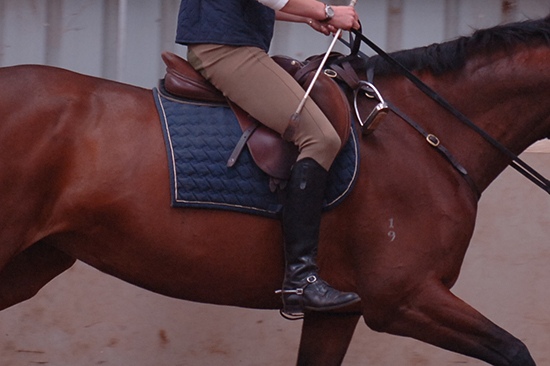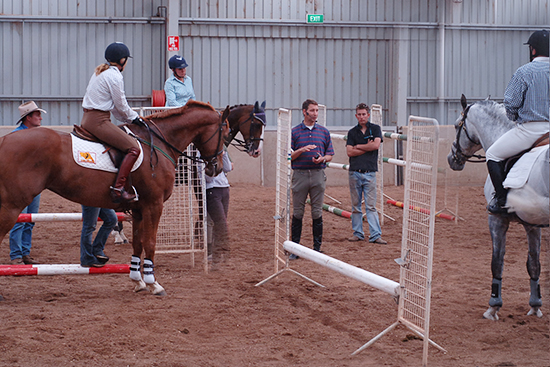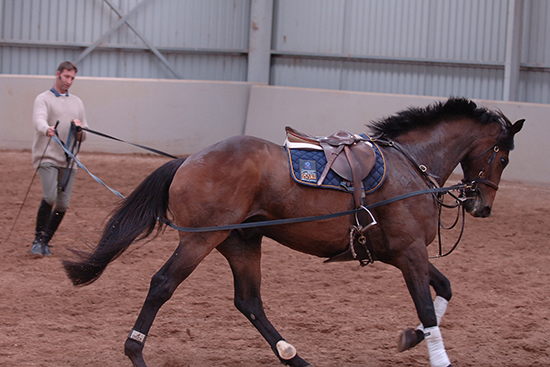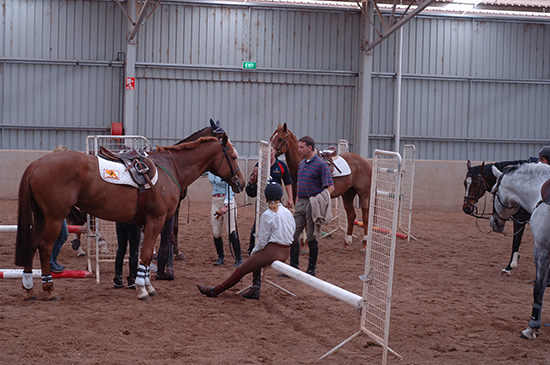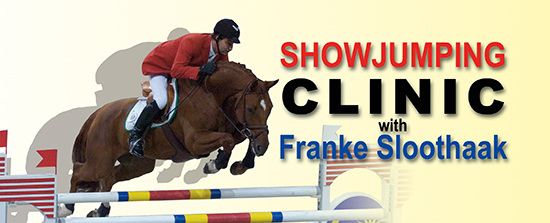 Story by Chris Hector and photos by Roz Neave
Story by Chris Hector and photos by Roz Neave
Despite being born and raised in Holland, Franke Sloothaak has ridden with enormous success for Germany, competing in a staggering 127 World Cup qualifiers for 18 wins, in 76 Nations Cups for 20 wins, with appearances at four Olympic Games for two gold medals and two World Championships, with gold each time.
Franke was the guest judge at this year’s Dressage & Jumping with the Stars, and in the days leading up to the competition, conducted a clinic in the number two indoor arena at Werribee.
Unfortunately I was only able to attend the second day, and missed the sight of the riders riding down a line of six verticals with no reins, no stirrups…
What’s it all about Franke – you don’t like riders??
“No I do it because I like horses. It’s a very good exercise for both horse and rider. When they don’t take the reins, the horses have to learn to balance on their own. The rider has no reins or stirrups, so they stay very close to the horse. Close contact, move with you horse. Don’t move in front of your horse.”
This was interesting because a lot of the time, we have jumping coaches asking riders to get into a forward, two point seat?
“Keep your body back, that’s the most important thing. Most of the riders are in front of their horse, leaning on the neck. It is always better to keep your position more back and keep the horse in front of you. First of all, you keep more control, because in light seat you cannot keep contact and control the horse very well. When you see riders with short reins, leaning on the horse’s neck, mostly those horses do not make a very nice jump because the horse doesn’t use its body. They have a contact with the mouth, jumping always against the bit, so they don’t have impulsion from behind. So how should they improve the horse’s jumping? My point is that I always try to develop a better shape over the jump. Improve the horse’s technique, improve the horse’s balance, help him to keep his body together, teach him so he gets strong enough to do the job. That’s why we need all these exercises…”
And Franke’s attitude to the way he presents his exercises comes from his experience as a young rider in Holland: “As a kid I had one trainer in Holland who was very good. He made nice exercises for juniors and young riders because he made a game of it. Trotting poles, in and outs, he was playing – everyone enjoyed the lessons and had fun, and by having fun, still learning. It’s not okay to always put pressure on the rider, they have to learn to enjoy it and they make a bigger effort, do it more correct – then afterwards, they get more back.”
“Then I have been so many years in the sport, so many years training with people. I gave my first clinics when I was 15 years old. So you watch and over the years you learn what sort of training sessions really improve the horses and the riders. You are always making two exercises, an exercise for the horse, an exercise for the rider. The two parts can go together at the same time… You can do it with a line of oxers, make them go without reins, try to keep their balance, try to follow the horse… But in the end, the main thing for every rider is their own discipline.”
Franke demonstrated two rein lunging to show how the exercise could help somewhat hot Thoroughbred better balance the canter…
“Mostly horses and riders are lazy, we have to force them to work, but then you can make exercises that they enjoy doing. In the Four Year Old Class, we had a horse that had been three days at the clinic, jumping every day, and still he jumped a beautiful round in the competition. The rider told me, I don’t have the feeling that he is tired even though he has been doing a lot. And I said, this is like when you ask joggers, they are addicted to jogging, it makes them feel good. It is the same with the horses, the better you feel – the more you enjoy it. So the better you work the horse, the more he will enjoy the job, and then in the end, when the horse enjoys his job, you will get the results.”
But first Franke wanted his riders to warm their horses in – LIKE DRESSAGE HORSES! There was no jumping until the horses were beautifully warmed in… And just like a dressage instructor, Franke was a stickler for good rider position over a fence: “We want the horse to stay together in the air, and it is hard if you are flying everywhere – keep your body under pressure, keep the horse together in the air, keep some shape over the jump. Ride from a system, from a distance, from a shape.”
And distance – like shape – came down to control: “If you are in control, you do what you want. No control and you have to take what you get.”
And the traditional – But I am riding a hot Thoroughbred – excuse, did not cut it: “Okay Thoroughbreds are hot, but even a Thoroughbred has to learn to take your leg. Most Thoroughbreds have colder minds than Warmbloods but you have to work on it. There is no excuse for not doing good flatwork. Every horse can learn – always ride the horse through. In Germany you can see how their horses teach the riders how to ride – okay it is harder here, but the riding must still be disciplined.”
“I ride because I want to win, and if you want to win, that means you have to work and keep going and not stop, even if you are having a bad day. I love the fact that if you treat horses well, they will forgive you. Winning starts with you, the rider.”
“In the warmup, the first thing the horses have to learn is to get more sensitive, then you can be more quiet in your riding. Keep your shoulders back, try to get the horse’s head a little down, hands quiet, body straight, try to keep the contact, keep your legs on.”
“Now a bit of shoulder in, round the inside leg, but bigger, more forward. Sit there, don’t stand up…”
And to make sure that happened: “Take the stirrups off. Ride a few minutes without stirrups, and remember, without impulsion, you can’t get respect. ”
“All these exercises are just to learn to use your leg, keep leg on the horse. The horse has to respect your leg, but not be scared. You feel the contact, and the horse accepts you. Keep your eyes to the front, look between the horse’s ears.”
“Don’t sit like you are sitting on a raw egg. Ride the horse – the horse has to learn that you are the person telling them how fast and what to do.”
“The first thing is you come with your leg, and GO. Then you can work – otherwise it all gets too heavy, and we want it light.”
“If the horse is spooky, never try to get it to face up to what it is spooking on, ride in shoulder-in – if you try to show him what he is spooking on, it will just get worse and worse. Always try to keep the horse’s mind open and fresh, the horse should concentrate on you, but be open and fresh.”
“Don’t kick – use a little spur, kick and your whole body becomes tense.”
It was time for some canter exercises, and as Franke joked later ‘if you want to teach flying changes come to a jumping rider’, but as with everything, he was particular about getting the changes right: “Sit and keep your body straight, keep the horse in front of you. Concentrate and keep your seat the same. I like to make the changes from true canter to counter canter on a twenty-metre circle.
“When you ask for the flying change, try and sit in the middle of the saddle. Don’t stand up. Don’t think too much about everything you do, don’t make it too studied, just do it. To change push the horse over with the new inside leg, and get him to look in the new direction, and just change – and don’t get so busy with your hands when you change.”
“You can play around and do anything – but you must be persistent, because things start to work then, then you feel how important it is to keep your seat correct. Play with the changes, play with the pirouettes, it is important that the horse keeps his mind open and does what you want.”
Before setting up his first little jumping exercise, Franke had the riders cantering over a pole on the ground: “Don’t look at the pole. If you look at the pole, you will never see a distance to the fence. The pole is always at a perfect distance. Pretend it is not there, and just come around in a normal canter.”




 Then Franke added a vertical and a little cavaletti coming out – and then things started to get really interesting. Can you explain the exercise with the trot rail to the jump to the little jump out? What were the distances in there?
Then Franke added a vertical and a little cavaletti coming out – and then things started to get really interesting. Can you explain the exercise with the trot rail to the jump to the little jump out? What were the distances in there?
“The front pole on the ground was like five metres from the fence, and the little cavaletti after the fence was three and a half metres away.”
The fence ended up quite high – how high can you get it?
“As high as you want it. It is a nice exercise because the horse has to use his body and clear the jumps – and when he’s made the jump the cavaletti is there to make sure he leaves the ground quickly again – so they don’t jump the fence and land dead on the ground. When they are over the fence, they still have to go forward again and lift their legs off the ground.”
“It is important because if the horses land in a bad way, and they are a long time on their front feet, that’s a soundness problem. We have to take care of their legs, and to keep them sound so it is important that they are balanced and they are light and quick, the quicker they are on their legs, the quicker they leave the ground, and the better it is. Heavy horse, heavy movement, then you have problems. The horse that moves light, that is not that much on the ground, they are always moving and they have less problems.”
But it wasn’t just the cavaletti coming out that made the exercise interesting, it was also the relationship between the pole and the fence – and Franke’s insistence that the riders give the horse time to find space in front of the fence:
“Slow down. Keep your legs on the horse. You all want to go too fast, and you can’t go too fast, there is no room in there to go fast. Slow down. Slow down. SLOW DOWN and SIT – you are already standing up over the pole, try to keep your seat on the horse. Don’t push forward – you should try to get room in front of the fence even though the pole is there. Let the fence come to you.”
“The pole is there to make life a little difficult. Try to canter as slow as possible. Thoroughbreds need form in front of a jump, the more time you can give your horse in front of the fence, the better it gets. Okay when a horse is hot it is hard to keep him soft. He still has to learn to wait, and learn to find room in front of the jump. Then he gets confidence. Sit back, wait, super – VERY GOOD.”
“Slow down, keep the rhythm the same and try to stay in the middle of the horse. Don’t hold them with the reins, keep them back with your body. Even if the horse gets strong, try to stay quiet, don’t move your hands so much. Use as much as you need, not more. Slow down with both hands, don’t fiddle with your hands. If you fiddle, then his head will come up and his back will hollow and then his hind legs won’t be there. Just hold them, they can’t understand you when you fiddle.”
“With this pole I force you to use your leg and your seat. Hands down, elbows on your body, look at the fence, the pole is always in a perfect place, and after the pole, kick forward, make him go. Then he learns when he lands, he must go, when you are over the white pole, land and go.”
“Once the horse gets active, then it is easier to slow him down, but if he is not active he can’t use his hindlegs.”
And just to re-inforce the activity, Franke is standing on the landing side with a lunging whip…
“Concentrate and ride a decent distance. If every time you have a different distance, it is very hard for the horse. In the end, it is the fence that makes the horse jump – if he makes a mistake, he will learn.”
And we can learn, thanks to gifted instructors, like Franke Sloothaak…
This article originally appeared in THM February 2007.

